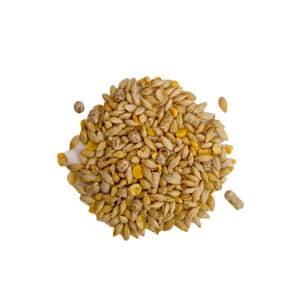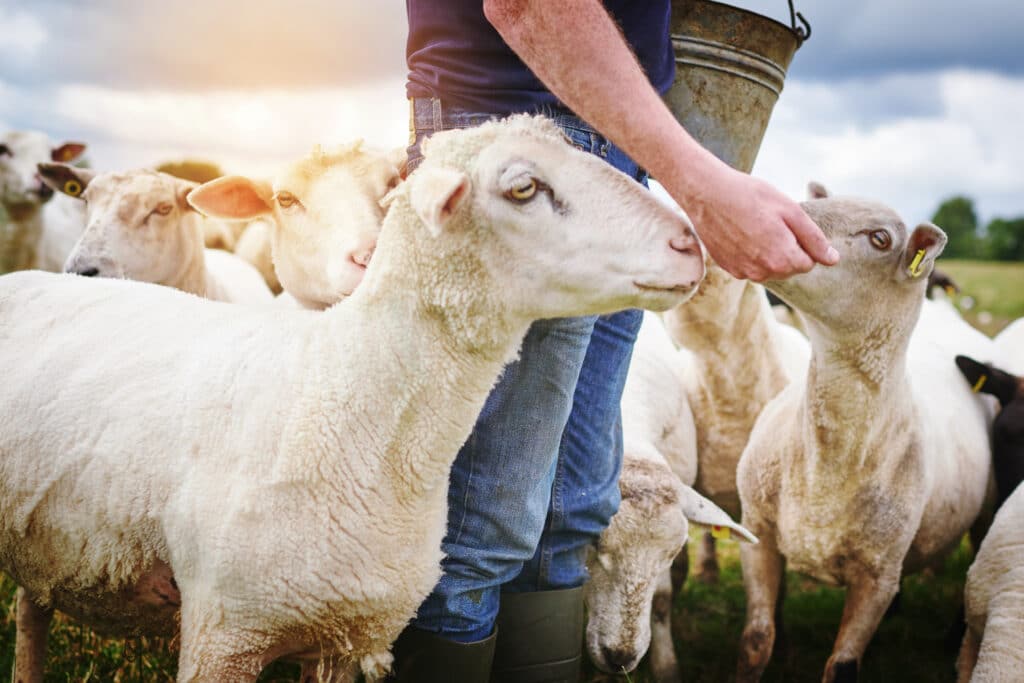As the cold weather breaks, the feed requirements of sheep change. Cold stress lowers, reducing the amount of feed sheep require to maintain body heat, and pasture quality improves.
The spring flush, where pastures have rapid green growth, increases grazing feed, but brings with it a risk of digestive issues and grass tetany.
Spring is also the season for lambs. Ewes require specific nutrition to support milk production while staying healthy and maintaining fertility, and lambs needs a good healthy start to boost survival and growth.
Key Nutritional Needs in Spring
According to the NSW Government Local Land Services, ‘for a medium-framed, Merino of 50kg mature weight in good condition with no fleece, the average feed requirements are presented below.
|
Livestock Class |
Energy required |
Protein (%) |
|
Dry Sheep |
8 |
6 |
|
Early pregnancy |
8 |
6 |
|
Last month of pregnancy |
||
|
Single |
14 |
8 |
|
Twin |
18 |
8 |
|
1st month of lactation |
||
|
Single |
20 |
12 |
|
Twin |
26 |
12 |
|
2nd and 3rd months of lactation |
||
|
Single |
14 |
12 |
|
Twin |
15 |
12 |
Note that sheep that do not produce wool have a 2–3% lower requirement to maintain the same weight.
· Energy
As you can see, energy needs for pregnant ewes rise from 8 MJ/kg DM to 14-18 MJ/kg DM towards the end of pregnancy, and 20-26 MJ/kg during the first month of lactation. Though sheep no longer have the cold stress of winter, their energy demands can triple during spring!
Conveniently, lambing season will often coincide with the spring flush, when peak pasture growth will support some of the increased energy needs.
According to ausfarmnutrition.com, this time of year is when winter-dominant pastures provide the highest nutritional values – with anywhere from 70 to 80% digestibility, with 10 to 12 MJ/kg DM and 22 to 26% protein.
So if your grazing pastures are sufficient, a dry sheep may not need any supplementary nutrition during the spring, but pregnant and lactating sheep will still require a bit of extra support.
· Protein
Protein is vital for milk production and lamb growth. As already mentioned, green pasture is high in protein, with around 22-26% protein. As the spring pastures start to mature though, coinciding with lamb weaning, both it’s digestibility and available protein drops. It’s around this time that supplement feeds may need to be introduced to meet protein requirements. Otherwise, lamb growth could drop off before they reach market weight or maturity.
· Minerals & vitamins
Minerals and vitamins, especially magnesium, calcium and phosphorus, are also very important during spring. Without the adequate intake of these minerals, proper bone development and milk production could suffer.
Once again, spring pastures can be a good source of magnesium, calcium and phosphorus, but there can be an imbalance. Some green feeds will have higher levels of phosphorus but not enough calcium. It’s important to check pastures and monitor feed intake, to make sure your flock gets what it needs during this critical time, and stays healthy.
The Risk of Grass Tetany
Grass tetany is an often-fatal condition caused be a magnesium deficiency in the blood. According to the NSW Government Local Land Services, ‘generally, young grass and lush cereals have lower magnesium levels than older grass and cereal crops.’
It is often a concern during this time of year, after the spring flush and during lambing season, when ewes have higher mineral requirements. Prevention involves magnesium supplementation, by providing hay/roughage or other supplements alongside grazing pastures.
Supplement Strategies
During spring, pasture growth can support a dry ewe, and will meet the majority of requirements for pregnant or lactating ewes. However, some supplementation is still needed to reduce the risk of grass tetany and to ensure that both the mothers and lambs are getting enough energy and vitamins to support milk production and healthy growth.
Testing feed pastures by sending samples away for analysis is an option, and will provide the most accurate information so you can make decisions on what supplements are required.
However, you can also monitor sheep condition, growth, and dung condition to tell if nutrition requirements are being met. If your spring pastures are at their peak, and there is plenty available, supplementary requirements will naturally be less. But it’s important to remember the below factors:
– Risk of grass tetany
– Higher requirements of pregnant and lactating ewes
– Maturing pastures
Look for a good vibrant green coloured pasture, and measure the height and density. As a rule of thumb, both roughage and clean water will be required alongside of grazing feed. If sheep condition is dropping off though, and you have pregnant or lactating ewes, consider the following supplements.
· Hay
Hay is a high-fibre source of nutrition, and often required alongside pasture feed anyway. It can help prevent grass tetany by providing calcium and improving the animals ability to absorb magnesium from the grass.
· Grain
Grain feeds are often more readily available than hay, and better value in terms of meeting energy and protein requirements. They do need to be introduced slowly and fed daily to avoid digestive issues. Cereal grains are the most common, providing a quick source of energy to help meet the increased requirements of lactating ewes and lambs.
Pulse grains, such as lupins, generally have a reduced risk of acidosis compared to cereal grains.
· Pellets
Pellets are a nutrient-dense feed option, generally combining both processed grains and vitamins to meet specific livestock needs. Different blends are formulated to meet specific requirements, such as maintaining body condition and milk production, and supporting pregnancy, which makes them ideal as a supplementary feed during spring. They can also give young animals a good head start for healthy and fast growth.
However, they can be more expensive than grain feeds, due to the processing costs and inclusion of vitamins and minerals.
· Lick Blocks
Lick Blocks are another option, often used alongside supplementary feeds when specific nutrients are lacking. They can be a convenient and cost-effective way of meeting specific nutrient deficiencies, such as magnesium, but they do not provide significant amounts of energy or protein. Just keep in mind that if animals already have a balanced diet, then these additional supplements are not necessary.
Seasons Range - Grain Mixes, Pellets, Concentrates

CowraFeed’s new Seasons Range (available in a Grain Mixes, Pellet, or Concentrate Pellet), are specifically formulated to help maintain body condition and milk production in ewes, whether they’re in pregnant, feeding lambs, or experiencing nutrition deficiency.
This range is designed to support key vitamin and nutrition needs, which is especially important when the pasture isn’t meeting nutritional requirements.
The Spring Seasons product includes added magnesium and calcium to assist with increased nutritional requirements around lambing, helping the prevention of grass tetany, and also includes selenium and zinc to help with joining and conception.
Using these feeds during spring and throughout lambing season will maintain condition of your pregnant ewes, support milk production, help prevent mineral deficiencies, and give your lambs a head start to healthy growth.
